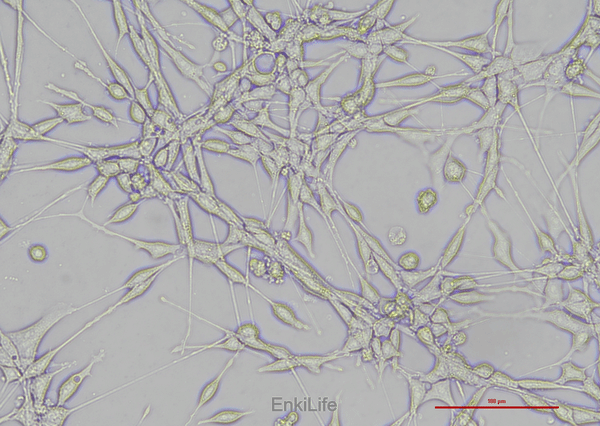小鼠结肠癌细胞CT26.WT
发表时间:2025-07-23小鼠结肠癌细胞CT26.WT
一、细胞起源
1.起源:CT26.WT源于BALB/c小鼠经化学致癌剂N-亚硝基-N-甲基尿烷(NMU)诱导的未分化结肠腺癌,具有高度侵袭性和转移特性[1]。
2.遗传背景:携带突变型KRAS基因和野生型p53,模拟了人类结肠癌的常见遗传变异[1]。

二、生物学特性
1.增殖与代谢:
- 高增殖速率,体外倍增时间约12–16小时[1]。
- 能量代谢依赖糖酵解和氧化磷酸化,抗增殖药物组合(OLD)可显著抑制其代谢灵活性[2]。
2.免疫逃逸机制:
- 高表达PD-L1,受IFN-γ调控,参与免疫检查点逃逸[3]。
- HMGB1过表达通过激活自噬(PI3KIII/Beclin-1通路)抵抗树突状细胞(DCs)诱导的凋亡[4]。
3.转移特性:
- 高表达 基质金属蛋白酶(MMP-2/9) 和MD2蛋白,促进迁移与肺转移[5]。
- S1P/S1PR2轴通过下调MHC-II表达抑制CD4?T细胞免疫监视[6]。
三、培养与储存
1.培养基: RPMI 1640 + 10%胎牛血清(FBS) ,CO?浓度5.0%[1][7]。
2.传代比例:1:3–1:5,每周2–3次。
3.冻存方法:90% FBS + 10% DMSO,液氮长期保存。
四、研究应用领域
1.肿瘤免疫治疗:
- 作为免疫治疗模型,用于评估PD-1/PD-L1抑制剂(如Aikejia联合疗法)[3]。
- 重组禽痘病毒(rFPV)递送肿瘤抗原可激活CD8?T细胞杀伤[8]。
2.药物筛选:
- 黄酮衍生物L2H17通过抑制NF-κB/PI3K-Akt通路诱导凋亡[9]。
- OLD组合(奥利司他+洛尼达胺+DON)抑制能量代谢并促进凋亡[2]。
3. 肿瘤微环境研究:
- 疟原虫感染通过破坏线粒体生物合成(抑制PGC-1α)抑制增殖并促进凋亡[10]。
五、近五年研究进展(2020–2025)
1. 新型免疫疗法:
- TS-L6(抗体-拓扑异构酶I抑制剂偶联物) 可诱导长期免疫记忆,100%排斥HER2?肿瘤再挑战[11]。
2. 代谢靶向治疗:
- OLD组合使细胞代谢表型向"静止态"转变,限制葡萄糖/谷氨酰胺利用[2]。
3. 天然产物抗肿瘤:
- 药用蘑菇提取物AGARIKON通过调节巨噬细胞极化(M1/M2)和抑制VEGF发挥抗血管生成作用[12]。
- 唇形科植物精油(如L. sidoides)选择性杀伤CT26.WT(IC??=19.06 μg/mL)[13]。
六、局限性及克服策略
1.局限性:
- 免疫异质性:缺乏人类免疫系统复杂性,限制了免疫治疗转化[3]。
- 药物递送效率低:内吞途径pH值偏低(pH<5.0),影响纳米载体递送效率[7]。
2.克服策略:
- 人源化小鼠模型:移植人源免疫细胞提升临床相关性[4]。
- 新型递送系统:FN多肽修饰的PEG化脂质体可靶向α5β1整合素提升摄取[14]。
七、总结与展望
CT26.WT作为经典的未分化结肠癌模型,在免疫治疗机制、代谢重编程和药物开发中不可或缺。未来需结合类器官共培养、单细胞测序等技术解析肿瘤异质性,并开发双特异性抗体及代谢-免疫联合疗法以突破当前治疗瓶颈。

参考文献
1. Targeting Hsp90 with NW457 radiosensitizes tumor cells. Linda A, et al. PLoS One. 2014;9(2):e89150.
2. The combination of orlistat, lonidamine and 6-diazo-5-oxo-L-norleucine induces a quiescent energetic phenotype in colon cancer cells. Schcolnik-Cabrera A, et al. Sci Rep. 2020;10(1):11163.
3. Immunopotentiator Aikejia improves the therapeutic efficacy of PD-1/PD-L1 blockade in CT26.WT cancer cells. Huang C, et al. Front Immunol. 2019;10:1285.
4. HMGB1 promotes autophagy-mediated survival in colon cancer co-cultured with dendritic cells. Zheng Y, et al. Oncol Rep. 2018;39(3):1247-1259.
5. Selective targeting of the TLR4 co-receptor, MD2, prevents colon cancer growth and lung metastasis. Rajamanickam V, et al. Int J Biol Sci. 2020 Feb 17;16(8):1288-1302. [PMID: 32210720]
6. The Sphingosine-1-Phosphate/Sphingosine-1-Phosphate Receptor 2 Axis in Intestinal Epithelial Cells Regulates Intestinal Barrier Function During Intestinal Epithelial Cells-CD4+T-Cell Interactions. Chen T, et al. Cell Physiol Biochem. 2018;48(3):1188-1200. [PMID: 30045015]
7. Endocytic Profiling of Cancer Cell Models Reveals Critical Factors Influencing LNP-Mediated mRNA Delivery and Protein Expression. Sayers EJ, et al. Mol Ther. 2019 Nov 6;27(11):1950-1962. [PMID: 31427168]
8. Active immunotherapy of cancer with a nonreplicating recombinant fowlpox virus encoding a model tumor-associated antigen. Wang M, et al. J Immunol. 1995 May 1;154(9):4685-92. [PMID: 7722321]
9. Chemopreventive effect of chalcone derivative, L2H17, in colon cancer development. Xu S, et al. Sci Rep. 2015;5:16144. [PMID: 26553361]
10. Plasmodium infection suppresses colon cancer growth via disrupting mitochondrial biogenesis. Yao X, et al. Cell Death Dis. 2022;13:34. [PMID: 35013129]
11. A HER2-targeted antibody-novel DNA topoisomerase I inhibitor conjugate induces durable adaptive antitumor immunity by activating dendritic cells. Tan X, et al. MAbs. 2023 Jan-Dec;15(1):2220466. [PMID: 37314961]
12. Antitumor, Immunomodulatory and Antiangiogenic Efficacy of Medicinal Mushroom Extract Mixtures in Advanced Colorectal Cancer Animal Model. Jakopovic B, et al. Molecules. 2020 Oct 28;25(21):5005. [PMID: 33126765]
13. Targeting colon cancer with fibronectin-mimetic peptide liposomes. Garg A, et al. Langmuir. 2008;24(20):11836-410. [PMID: 18778031]
14. Active immunotherapy of cancer with a nonreplicating recombinant fowlpox virus encoding a model tumor-associated antigen. Wang M, et al. J Immunol. 1995;154(9):4685-92. [PMID: 7537761]




